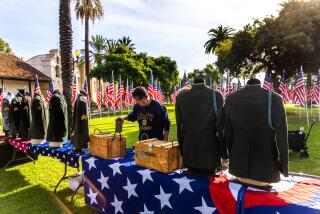Airlooms: Fliers, Fans Gather to Pay Tribute to Vintage Craft
- Share via
Aviation got in Russ Drosendahl’s blood when he was a boy and it never left. He cut his teeth flying B-24s during World War II, then moved on to a career as an airline pilot for more than three decades.
“Flying has been my avocation as well as my vocation,” said Drosendahl, 65. “I’ve never tired of it. And I want to continue with it.”
So it was that Drosendahl spent most of Saturday standing beside the sheet-metal expanse of a chubby C-46 cargo plane dubbed “China Doll” at Brown Field, near the border, taking part in the third annual exhibition of World War II aircraft sponsored by the San Diego chapter of the Confederate Air Force.
About 20,000 spectators flocked to the airport to ogle dozens of high-performance fighter planes, lumbering bombers and other reconditioned relics of a bygone era as part of the three-day event, which runs through today.
While Drosendahl and scores of other aviation aficionados explained the intricacies of the various World War II aircraft displayed on the ground, several old-timers took to the sky in the vintage planes, dancing atop the clouds and then roaring down to not much more than a wing’s length from the earth.
“They’re still the most exciting aircraft around,” said Dennis Stewart, a member of the group’s San Diego-area wing. “They look the way propeller airplanes ought to look.”
As devotees of the Confederate Air Force see it, the World War II aircraft are probably the best flying machines ever built--tough, aerially agile planes that can fly loop-de-loops around most contemporary civilian aircraft.
An example: Drosendahl, a member of the Los Angeles chapter, flew just about everything in his more than 34 years as a commercial pilot, from the DC-3 to ultra-modern jumbo jets. But, given a choice, he would prefer a nice, 40-year-old B-29 or a Spitfire any day of the week.
“You get these things in you, and you don’t get them out until you die,” Drosendahl said, gazing up at the big cargo plane his chapter displays at various air shows throughout the West.
He certainly is not alone. The Confederate Air Force has more than 30 chapters throughout the United States, and others operate in Canada, Australia and Great Britain. The organization, which is the oldest and largest group devoted to restoring and maintaining World War II-era aircraft, has about 10,000 members.
Though it now maintains perhaps the greatest collection of vintage fighting planes in the world, the group sprang up in the 1950s almost by accident, Drosendahl said.
About 30 years ago, some veteran World War II flyers in Texas bought a battered P-51 and began restoring the high-performance fighter plane. While “shooting the breeze” one day, Drosendahl said, the aviators realized that lots of planes from the war were being relegated to the scrap heap--an inglorious end for machines that served the Allied cause so magnificently.
Eager to salvage a bit of history, the group decided to form the Confederate Air Force. Today, the organization has more than 100 World War II aircraft, all of them restored and in flying condition. Among those aircraft are a vintage B-17 “Flying Fortress,” a legendary bomber that was by far the most popular with the crowd at Brown Field, and an exotic, P-38 Lockheed Lightning restored and piloted by renowned military ace Lefty Gardner.
All the restoration work, however, costs money. The organization’s annual dues of $160 per member hardly begins to cover the cost of new parts, fuel and other expenses. The C-46 operated by the Los Angeles chapter, for instance, cost $19,000 to restore and drains about $350 an hour to fly.
With those sorts of expenses in mind, the various wings hold air shows to raise extra revenue. Typically, the air shows run from April through November, and all of the group’s wings come together in October for a nationwide event at the national headquarters in Harlingen, Tex.
During the winter, the bulk of the restoration work is performed, as the various wings hold “maintenance-work parties” to strip and clean the aircraft.
It’s a labor of love. Jim Ferguson, a private collector who has owned an AT-6 military trainer since 1961, said the World War II-era planes are the most reliable, despite their age.
“I’m just going on my second engine,” said Ferguson. “This thing is built like a tank.”
More to Read
Sign up for The Wild
We’ll help you find the best places to hike, bike and run, as well as the perfect silent spots for meditation and yoga.
You may occasionally receive promotional content from the Los Angeles Times.






